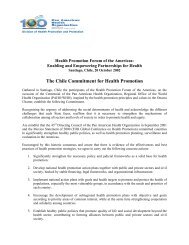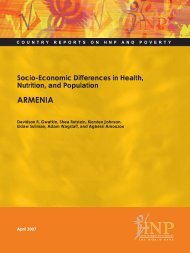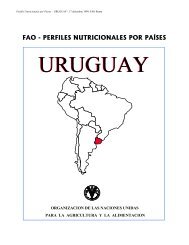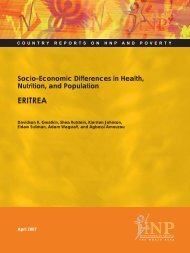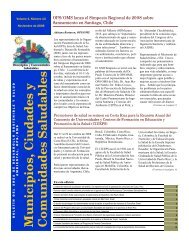Guidelines for drinking-water quality. Volume 1 - BVSDE
Guidelines for drinking-water quality. Volume 1 - BVSDE
Guidelines for drinking-water quality. Volume 1 - BVSDE
You also want an ePaper? Increase the reach of your titles
YUMPU automatically turns print PDFs into web optimized ePapers that Google loves.
2. Microbiological aspects<br />
2.1 Agents of significance<br />
2.1.1 Waterborne infections<br />
Infectious diseases caused by pathogenic bacteria, viruses, and protozoa or by parasites are the<br />
most common and widespread health risk associated with <strong>drinking</strong>-<strong>water</strong>.<br />
Infectious diseases are transmitted primarily through human and animal excreta, particularly<br />
faeces. If there are active cases or carriers in the community, then faecal contamination of <strong>water</strong><br />
sources will result in the causative organisms being present in the <strong>water</strong>. The use of such <strong>water</strong><br />
<strong>for</strong> <strong>drinking</strong> or <strong>for</strong> preparing food, contact during washing or bathing, and even inhalation of <strong>water</strong><br />
vapour or aerosols may then result in infection.<br />
2.1.2 Orally transmitted infections of high priority<br />
The human pathogens that can be transmitted orally by <strong>drinking</strong>-<strong>water</strong> are listed in Table 1 (p.<br />
10), together with a summary of their health significance and main properties. Those that present<br />
a serious risk of disease whenever present in <strong>drinking</strong>-<strong>water</strong> include Salmonella spp., Shigella<br />
spp., pathogenic Escherichia coli, Vibrio cholerae, Yersinia enterocolitica, Campylobacter jejuni,<br />
and Campylobacter coli, the viruses listed in Table 1, and the parasites Giardia spp.,<br />
Cryptosporidium spp., Entamoeba histolytica, and Dracunculus medinensis. Most of these<br />
pathogens are distributed worldwide. However, outbreaks of cholera and infection by the guinea<br />
worm D. medinensis are regional. The elimination of all these agents from <strong>water</strong> intended <strong>for</strong><br />
<strong>drinking</strong> has high priority. Eradication of D. medinensis is a recognized target of the World Health<br />
Assembly (World Health Assembly resolution WHA44.5, 1991).<br />
2.1.3 Opportunistic and other <strong>water</strong>-associated pathogens<br />
Other pathogens are accorded moderate priority in Table 1 or are not listed, either because they<br />
are of low pathogenicity, causing disease opportunistically in subjects with low or impaired<br />
immunity, or because, even though they cause serious diseases, the primary route of infection is<br />
by contact or inhalation, rather than by ingestion.<br />
Opportunistic pathogens are naturally present in the environment and are not <strong>for</strong>mally regarded<br />
as pathogens. They are able to cause disease in people with impaired local or general defence<br />
mechanisms, such as the elderly or the very young, patients with burns or extensive wounds,<br />
those undergoing immunosuppressive therapy, or those with acquired immunodeficiency<br />
syndrome (AIDS). Water used by such patients <strong>for</strong> <strong>drinking</strong> or bathing, if it contains large<br />
numbers of these organisms, can produce various infections of the skin and the mucous<br />
membranes of the eye, ear, nose, and throat. Examples of such agents are Pseudomonas<br />
aeruginosa and species of Flavobacterium, Acinetobacter, Klebsiella, Serratia, Aeromonas, and<br />
certain “slow-growing” mycobacteria.<br />
Certain serious illnesses result from inhalation of <strong>water</strong> in which the causative organisms have<br />
multiplied because of warm temperatures and the presence of nutrients. These include<br />
Legionnaires’ disease (Legionella spp.) and those caused by the amoebae Naegleria fowleri<br />
(primary amoebic meningoencephalitis) and Acanthamoeba spp. (amoebic meningitis, pulmonary<br />
infections).<br />
Schistosomiasis (bilharziasis) is a major parasitic disease of tropical and sub-tropical regions, and<br />
is primarily spread by contact with <strong>water</strong> during bathing or washing. The larval stage (cercariae)<br />
released by infected aquatic snails penetrates the skin. If pure <strong>drinking</strong>-<strong>water</strong> is readily available,<br />
it will be used <strong>for</strong> washing, and this will have the benefit of reducing the need to use contaminated




